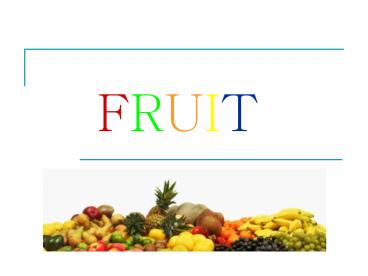FRUIT - PowerPoint PPT Presentation
1 / 21
Title: FRUIT
1
- FRUIT
2
Why eat fruit?
- Health benefits
- Reduced risk of some chronic diseases
- Heart disease - including heart attack and stroke
- Some types of cancer
- Obesity
- Type 2 diabetes
- High blood pressure
- Kidney stones
- Bone loss
- It gives us quick energy
- Contains little or no fat and no cholesterol
3
Why eat fruit?
- Provides nutrients vital for health and
maintenance of your body - Fiber - helps our digestion
- Whole or cut-up fruits are sources of dietary
fiber fruit juices contain little or no fiber - Potassium - helps to maintain healthy blood
pressure. - Fruit sources of potassium include bananas,
prunes and prune juice, dried peaches and
apricots, cantaloupe, honeydew melon, and orange
juice - Vitamin C - important for growth and repair of
all body tissues, helps heal cuts and wounds, and
keeps teeth and gums healthy - Citrus fruits like lemons, limes, oranges, and
grapefruit - Vitamin A - prevents night blindness
- found in fruits that are yellow to red in color
like Yellow melons, pineapples, apricots,
peaches
4
Selecting fresh fruit
- Buy fruits that are. . .
- Firm to the touch
- The right color
- Well shaped
- Heavy for their size
- Aromatic
- In good condition
- In season
- When in season HIGH in quality, LOW in price
- Avoid fruits that are. . .
- Too soft
- Too hard
- Green or under ripe
- Damaged
- Bruised
- Decayed
- Mildewed
- Discolored
5
Fresh Fruits
- Ripen fruits (peaches, pears, plums, bananas) at
room temperature and then store in refrigerator. - Ripe fruits are perishable and should be stored
in special drawer to prevent rapid loss of
moisture. - Wash before storage (except for berries)
- Handle gently to avoid bruising
6
Oxidation
- When cut fruit is exposed to the air and turns
brown. - Prevention put fruit in lemon juice or vinegar.
7
Canned Fruit
- May be whole, sliced, or in pieces.
- Come packed in juice or light, heavy or extra
heavy syrup - Usually less expensive than frozen or fresh
- Cost depends on brand, can size, quality, and
packing liquid - Choose jars free from dents, bulges, leaks
- Cover and store in refrigerator after opening
8
Frozen Fruit
- Available sweetened and unsweetened, whole or in
pieces - Most common blueberries, raspberries,
strawberries, and cherries - May loose texture quality during freezing
- Less expensive than fresh
- Store in coldest part of freezer
- After thawing store in tightly covered container
in fridge - Use as soon as possible and do not refreeze
9
Dried Fruit
- High in calorie density, so eat in moderation
- 1 cup of grapes 20 calories
- 1 cup of raisins 520 calories
- Most common raisins, cranberries, prunes, dates,
and apricots, apples, peaches, pears, figs,
pineapple, bananas, and papayas - Choose fruits that are fairly soft and pliable
- Store unopened in a cool, dry, dark place
- After opening store in air tight containers
10
What is it?
11
- cactus pear
- cactus fruit
- cactus fig
- Indian fig
12
What is it?
13
Cherimoya
- Some characterize the flavor as a blend
of banana, pineapple, papaya, peach,
and strawberry. - Others describe it as tasting like
commercialbubblegum.
14
What is it?
15
- Mango
16
What is it?
17
- Pomegranite
18
What is it?
19
- Star Fruit
20
What is it?
21
- Papaya































